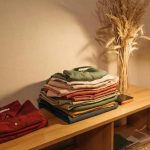Spunbond polypropylene fabric is a lightweight, durable nonwoven material made by bonding continuous polypropylene fibers. You’ll find it offers a smooth texture, excellent breathability, and water resistance, making it ideal for medical, packaging, and agricultural uses. It’s strong yet flexible, resists moisture, and helps maintain hygiene by preventing bacteria growth. Plus, it’s easy to care for and increasingly made with sustainability in mind. Keep exploring, and you’ll discover even more about its unique benefits and uses.
Table of Contents
Key Takeaways
- Spunbond polypropylene fabric is a lightweight, durable nonwoven material made from bonded continuous polypropylene fibers.
- It features a smooth, soft texture with uniform strength and excellent breathability, resisting wrinkles and maintaining shape.
- The fabric is breathable yet water-repellent, preventing liquid absorption and promoting hygiene by inhibiting mold and bacteria growth.
- Manufactured via extrusion, web formation, and thermal bonding, it offers consistent quality without adhesives or chemical binders.
- Its durability, moisture resistance, and recyclability make it suitable for medical, agricultural, packaging, and eco-conscious applications.
Definition and Composition of Spunbond Polypropylene Fabric
Spunbond polypropylene fabric is a type of nonwoven material made by bonding continuous polypropylene fibers together. When you use this fabric, you benefit from its lightweight yet durable nature.
It’s composed primarily of polypropylene, a thermoplastic polymer known for its toughness and resistance to chemicals. Because the fibers are bonded without weaving or knitting, the fabric offers uniform strength and excellent breathability.
You’ll also notice that it doesn’t absorb moisture, making it ideal for applications where water resistance matters. Its smooth texture feels comfortable against the skin while providing reliable filtration and protection.
Understanding its definition and composition helps you appreciate why this fabric performs so well across various industries, from medical supplies to agriculture and packaging.
Manufacturing Process Explained
To create a fabric with such strength and breathability, the manufacturing process plays a key role. You start by melting polypropylene pellets and extruding them through spinnerets to form continuous filaments. These filaments are then laid randomly on a conveyor to form a web. Next, the web passes through heated rollers that bond the fibers together without using adhesives or chemicals. This bonding gives the fabric its durability and lightweight properties.
| Step | Description | Purpose |
|---|---|---|
| Extrusion | Melt and form filaments | Create continuous fibers |
| Web Formation | Lay fibers randomly | Build fabric structure |
| Thermal Bonding | Heat and press web | Strengthen and bond fibers |
| Cooling | Cool fabric post-bonding | Stabilize final product |
Physical Properties and Texture
You’ll notice that this fabric combines strength with a lightweight feel, making it both durable and comfortable.
Spunbond polypropylene fabric has a smooth, slightly matte surface that’s soft to your touch yet resilient. It resists wrinkling and maintains its shape well, so it won’t sag or bunch up during use.
This fabric stays smooth and wrinkle-free, soft to touch yet durable without sagging or bunching.
The fabric’s fine, continuous filaments create a uniform texture without roughness or irritation, which makes it suitable for extended wear or contact.
Because it’s nonwoven, you won’t find the typical weave patterns, giving it a sleek, consistent appearance.
You’ll appreciate how easy it’s to handle—flexible enough to fold or drape but sturdy enough to hold up under stress, making it ideal for various practical applications.
Breathability and Moisture Resistance
Breathability plays a key role in making polypropylene fabric comfortable for various uses. When you wear or use items made from spunbond polypropylene, its breathable nature helps keep air flowing, preventing overheating and discomfort. This quality makes it ideal for applications like medical gowns, masks, and reusable shopping bags, where ventilation is important.
At the same time, spunbond polypropylene resists moisture effectively. It repels water and prevents liquid absorption, so you stay dry even in damp conditions. This moisture resistance also helps inhibit mold and bacteria growth, enhancing hygiene.
Because it balances breathability with moisture protection, you get fabric that’s both comfortable and practical for many everyday and industrial applications.
Environmental Impact and Sustainability
While spunbond polypropylene offers comfort and moisture resistance, its impact extends beyond performance.
You should know that, as a synthetic polymer, it relies on fossil fuels for production, which contributes to carbon emissions.
However, manufacturers are working to improve sustainability by incorporating recycled materials and optimizing energy use.
You can also recycle spunbond polypropylene, but it requires proper facilities and consumer participation.
Compared to some alternatives, it’s lightweight and durable, which reduces waste over time.
If you’re mindful about disposal and sourcing, you can help minimize environmental harm.
Choosing products made with responsibly sourced or recycled spunbond polypropylene supports a more sustainable future without sacrificing the fabric’s benefits.
Common Applications Across Industries
Because spunbond polypropylene combines durability with lightweight versatility, industries widely use it in various applications.
You’ll find it in medical settings as surgical gowns, masks, and drapes, thanks to its barrier properties and breathability.
In agriculture, it protects crops by covering plants to shield them from pests and harsh weather.
The packaging industry relies on it for reusable bags and protective wraps, offering strength without adding bulk.
You’ll also see it in automotive interiors for insulation and upholstery components.
Additionally, the construction sector uses spunbond polypropylene as geotextiles to reinforce soil and control erosion.
These varied uses highlight how this fabric meets different needs effectively, making it a practical choice across multiple fields.
Advantages Over Other Nonwoven Fabrics
What sets spunbond polypropylene apart from other nonwoven fabrics? You’ll find it offers superior strength and durability without adding weight.
Unlike some nonwovens, it resists tearing and maintains its shape, making it reliable for long-term and repeated use. You’ll also appreciate its excellent breathability combined with water resistance, providing comfort while protecting against moisture.
It’s chemically inert, so it won’t degrade when exposed to common substances, enhancing its lifespan compared to other materials. Plus, spunbond polypropylene is cost-effective to produce, which means you get high performance without a steep price.
If you need a fabric that balances strength, versatility, and affordability, spunbond polypropylene stands out as a practical choice over many alternatives.
Care and Maintenance Tips
To keep your spunbond polypropylene fabric in great shape, you’ll want to follow proper cleaning methods that avoid harsh chemicals.
Storing it in a cool, dry place helps prevent damage and extends its lifespan.
Let’s look at the best ways to care for and maintain this durable material.
Cleaning Methods
How should you clean spunbond polypropylene fabric to keep it in top condition? Since it’s durable yet sensitive to high heat, you’ll want to handle it gently to maintain its texture and strength.
Avoid harsh chemicals and high temperatures that could damage the fibers. Instead, follow these simple cleaning methods:
- Use a mild detergent and cold or lukewarm water for washing.
- Gently hand wash or use a delicate cycle if machine washing.
- Avoid bleach or fabric softeners, as they can degrade the fabric.
- Air dry the fabric away from direct sunlight or heat sources to prevent warping or shrinking.
Storage Guidelines
Although spunbond polypropylene fabric is tough, storing it properly guarantees it stays in great shape for longer. You should keep it in a cool, dry place away from direct sunlight to prevent fading and degradation. Avoid folding it too tightly to maintain its structure and reduce creases. Keep it away from sharp objects to prevent tears or punctures. Use breathable storage bags or containers to allow air circulation and avoid moisture buildup.
| Storage Tip | Reason | Recommendation |
|---|---|---|
| Cool, dry location | Prevents mold and fading | Store indoors, away from heat |
| Avoid tight folding | Maintains fabric integrity | Roll or loosely fold |
| Use breathable bags | Allows air circulation, prevents moisture | Cotton or mesh bags preferred |
Future Trends and Innovations in Spunbond Polypropylene
You’ll see spunbond polypropylene evolving with sustainable materials that reduce environmental impact.
Innovations will also boost durability, making the fabric last even longer under tough conditions.
Plus, smart fabric integration will add new functionalities to meet your growing needs.
Sustainable Material Advancements
As industries push for greener solutions, spunbond polypropylene is evolving with sustainable innovations that reduce environmental impact without sacrificing performance.
You’ll find these advancements making the fabric more eco-friendly and versatile. Manufacturers are focusing on reducing energy consumption during production and incorporating recycled materials to lessen waste.
Plus, new biodegradable additives help the fabric break down more easily after use.
Here are key sustainable advancements to watch:
- Using recycled polypropylene to cut down virgin plastic use
- Enhancing energy-efficient manufacturing processes
- Developing biodegradable spunbond fabrics for reduced landfill impact
- Innovating with bio-based polypropylene from renewable resources
Enhanced Durability Techniques
Three cutting-edge techniques are transforming the durability of spunbond polypropylene, ensuring it performs better and lasts longer in demanding applications.
First, advanced polymer blending enhances fiber strength, making the fabric more resistant to tears and abrasions.
Next, surface treatments like plasma and corona discharge improve bonding and increase resistance to chemicals and UV exposure, which means you can rely on the material even in harsh environments.
Finally, multilayer lamination combines spunbond layers with other materials, boosting tensile strength and moisture resistance without sacrificing flexibility.
By adopting these innovations, you get spunbond polypropylene that stands up to tough conditions, extends product life, and reduces replacement frequency—perfect for industries where durability is non-negotiable.
These techniques are setting new standards in performance, giving you confidence in your fabric’s longevity.
Smart Fabric Integration
Building on the advances in durability, spunbond polypropylene is now entering a new era with smart fabric integration.
You’ll find that combining this fabric with sensors and conductive materials opens up exciting possibilities. This innovation lets you interact with your textiles like never before, enhancing functionality beyond traditional uses.
Here’s what smart spunbond polypropylene can offer you:
- Real-time health monitoring through embedded sensors
- Temperature regulation adapting to your environment
- Interactive clothing that changes color or pattern based on stimuli
- Enhanced connectivity for wearable technology integration
As these technologies develop, you’ll see spunbond polypropylene becoming a key player in smart textiles, making your everyday fabrics smarter, more responsive, and highly practical.
Frequently Asked Questions
Can Spunbond Polypropylene Fabric Be Dyed or Printed On?
You can dye or print on spunbond polypropylene fabric, but it’s tricky since it resists traditional methods. You’ll need special inks or surface treatments to guarantee colors stick well and don’t fade quickly over time.
Is Spunbond Polypropylene Fabric Safe for Food Contact?
You can trust spunbond polypropylene fabric for food contact since it’s non-toxic, resistant to moisture, and doesn’t leach harmful chemicals. Just verify it meets food safety standards before using it with edible items.
How Does Temperature Affect Spunbond Polypropylene Fabric Performance?
Imagine using spunbond polypropylene in a greenhouse; when temperatures rise above 80°C, the fabric weakens and shrinks. You’ll notice reduced durability, so keep it below that to maintain strong, reliable performance in heat.
Can Spunbond Polypropylene Fabric Be Recycled Easily?
You can recycle spunbond polypropylene fabric, but it depends on local facilities. Its single-polymer composition makes recycling easier than mixed materials, so check your area’s recycling guidelines to guarantee proper disposal and maximize environmental benefits.
What Are the Cost Differences Compared to Woven Polypropylene Fabric?
You’ll find spunbond polypropylene fabric generally costs less than woven polypropylene because its production is simpler and faster. However, woven polypropylene offers greater durability, which might justify its higher price depending on your project needs.
- Tetron Fabric Suit: Style and Comfort Combined - June 17, 2025
- Tetron Fabric for Bags: Durability and Design Tips - June 17, 2025
- Tetron White Fabric: Style and Application Guide - June 17, 2025







